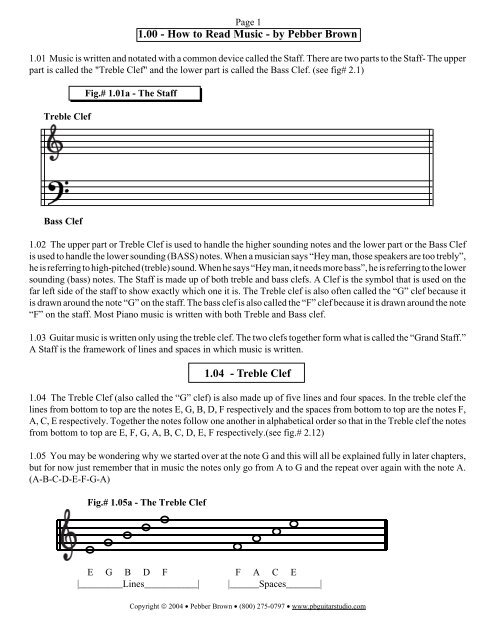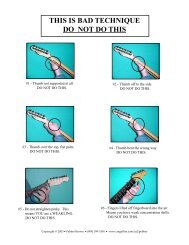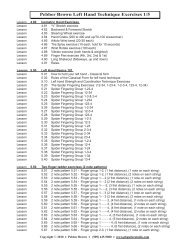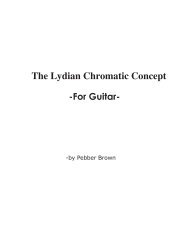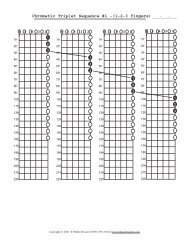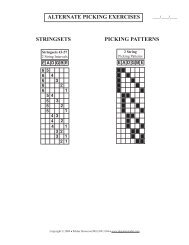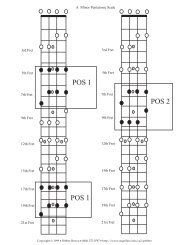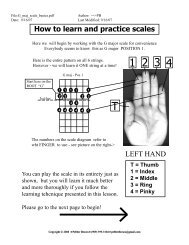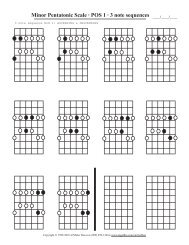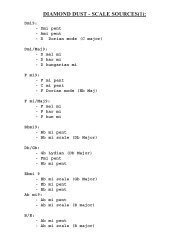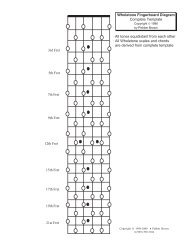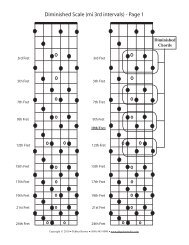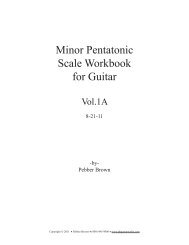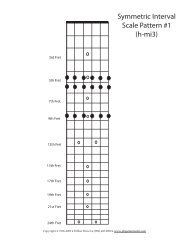1.00 - How to Read Music - by Pebber Brown ... - PB Guitar Studios
1.00 - How to Read Music - by Pebber Brown ... - PB Guitar Studios
1.00 - How to Read Music - by Pebber Brown ... - PB Guitar Studios
You also want an ePaper? Increase the reach of your titles
YUMPU automatically turns print PDFs into web optimized ePapers that Google loves.
Page 1<br />
<strong>1.00</strong> - <strong>How</strong> <strong>to</strong> <strong>Read</strong> <strong>Music</strong> - <strong>by</strong> <strong>Pebber</strong> <strong>Brown</strong><br />
1.01 <strong>Music</strong> is written and notated with a common device called the Staff. There are two parts <strong>to</strong> the Staff- The upper<br />
part is called the "Treble Clef" and the lower part is called the Bass Clef. (see fig# 2.1)<br />
Treble Clef<br />
Bass Clef<br />
Fig.# 1.01a - The Staff<br />
1.02 The upper part or Treble Clef is used <strong>to</strong> handle the higher sounding notes and the lower part or the Bass Clef<br />
is used <strong>to</strong> handle the lower sounding (BASS) notes. When a musician says “Hey man, those speakers are <strong>to</strong>o trebly”,<br />
he is referring <strong>to</strong> high-pitched (treble) sound. When he says “Hey man, it needs more bass”, he is referring <strong>to</strong> the lower<br />
sounding (bass) notes. The Staff is made up of both treble and bass clefs. A Clef is the symbol that is used on the<br />
far left side of the staff <strong>to</strong> show exactly which one it is. The Treble clef is also often called the “G” clef because it<br />
is drawn around the note “G” on the staff. The bass clef is also called the “F” clef because it is drawn around the note<br />
“F” on the staff. Most Piano music is written with both Treble and Bass clef.<br />
1.03 <strong>Guitar</strong> music is written only using the treble clef. The two clefs <strong>to</strong>gether form what is called the “Grand Staff.”<br />
A Staff is the framework of lines and spaces in which music is written.<br />
1.04 - Treble Clef<br />
1.04 The Treble Clef (also called the “G” clef) is also made up of five lines and four spaces. In the treble clef the<br />
lines from bot<strong>to</strong>m <strong>to</strong> <strong>to</strong>p are the notes E, G, B, D, F respectively and the spaces from bot<strong>to</strong>m <strong>to</strong> <strong>to</strong>p are the notes F,<br />
A, C, E respectively. Together the notes follow one another in alphabetical order so that in the Treble clef the notes<br />
from bot<strong>to</strong>m <strong>to</strong> <strong>to</strong>p are E, F, G, A, B, C, D, E, F respectively.(see fig.# 2.12)<br />
1.05 You may be wondering why we started over at the note G and this will all be explained fully in later chapters,<br />
but for now just remember that in music the notes only go from A <strong>to</strong> G and the repeat over again with the note A.<br />
(A-B-C-D-E-F-G-A)<br />
Fig.# 1.05a - The Treble Clef<br />
E G B D F F A C E<br />
|_________Lines___________| |______Spaces_______|<br />
Copyright © 2004 • <strong>Pebber</strong> <strong>Brown</strong> • (800) 275-0797 • www.pbguitarstudio.com
Page 2<br />
1.06 In the Treble Clef, the order of the notes appearing on the lines can be memorized <strong>by</strong> repeating the phrase<br />
“Every_Good_Boy_Does_Fine” and the spaces can be memorized <strong>by</strong> seeing the word “FACE” in the order of spaces.<br />
1.07 The Treble Clef is E-G-B-D-F for lines and F-A-C-E for spaces. The Bass Clef is G-B-D-F-A for lines and<br />
ACEG for spaces.<br />
Treble Clef = E G B D F F A C E<br />
|____Lines____| |____Spaces___|<br />
Bass Clef = G B D F A A C E G<br />
|____Lines____| |____Spaces___|<br />
1.08 - Bass Clef<br />
1.08 The Bass Clef (also called the “F” clef) is made up of five lines and four spaces. The lines from bot<strong>to</strong>m <strong>to</strong> <strong>to</strong>p<br />
are the notes G, B, D, F & A respectively and the spaces from bot<strong>to</strong>m <strong>to</strong> <strong>to</strong>p are the notes A, C, E, G respectively.<br />
Together both the lines and spaces form the notes in alphabetical order so from the bot<strong>to</strong>m <strong>to</strong> the <strong>to</strong>p of the bass clef<br />
all the notes are A, B, C, D, E, F, G & A respectively. (see fig# 1.08a)<br />
Fig.# 1.08a - The Bass Clef<br />
G B D F A A C E G<br />
|_________Lines___________| |_______Spaces_______|<br />
1.09 The order of the notes on the lines can be memorized <strong>by</strong> repeating the sentence “Good_Boys_Do_Fine_Always”<br />
and the notes occupying the spaces can be memorized <strong>by</strong> repeating the phrase “All_Cows_Eat_Grass”. Whenever<br />
you look at the Bass Clef on the screen you can use these sentences <strong>to</strong> keep track of exactly where you are.<br />
1.10 - Mnemonics:<br />
1.10 Often times in the study of music theory or other disciplines, quite a bit of memorization is required. In order<br />
<strong>to</strong> memorize information we use what are called “Mnemonics” or “Mnemonic devices”. A Mnemonic device is<br />
a little idea or phrase that helps you remember the information. For example, the phrase “All_Cows_Eat_Grass” helps<br />
us <strong>to</strong> remember the order of the notes A-C-E-G.<br />
1.11 This book is literally filled with all kinds of mnemonic devices and some of them have been used <strong>by</strong> music<br />
teachers for centuries and others have been invented <strong>by</strong> the author. Please feel free <strong>to</strong> invent your own mnemonic<br />
devices if you think of a better one than the ones listed in this book.<br />
Copyright © 2004 • <strong>Pebber</strong> <strong>Brown</strong> • (800) 275-0797 • www.pbguitarstudio.com
Page 3<br />
1.12 For further research in<strong>to</strong> mnemonic devices and memory techniques, please read any books <strong>by</strong> Mr. Harry<br />
Lorayne on memory improvement techniques.<br />
1.13 - Time Signatures<br />
1.13 In order for <strong>Music</strong>ians (or computers) <strong>to</strong> be able <strong>to</strong> play a given piece of music, they need <strong>to</strong> know how the<br />
beat goes. We notate the beat of a composition using a device called a “Time Signature”. A Time Signature explains<br />
<strong>to</strong> the musician how many beats the song has and how it is timed. For example a song that is written in 4/4 time has<br />
4 beats per measure. What that means is that you count 1-2-3-4, 1-2-3-4, 1-2-3-4 over and over again.<br />
Some commonly used time signatures are:<br />
2 3 4 5<br />
(Two/Four) (Three/Four) (Four/Four) (Five/Four)<br />
4 4 4 4<br />
3 5 7 9<br />
(Three/Eight) (Five/Eight) (Seven/Eight) (Nine/Eight)<br />
8 8 8 8<br />
1.14 Quite simply, you can look at the time signature and count the TOP number over and over again. If a song is<br />
in 3/4 time, you count 1-2-3, 1-2-3 over and over again (like a waltz).<br />
1.15 The bot<strong>to</strong>m number indicates what kind of note gets one beat. If the Bot<strong>to</strong>m number is 4, then a QUARTER<br />
note gets one beat. If the bot<strong>to</strong>m number is 8, then an EIGHTH note gets one beat. If you look at time signautes<br />
they look like mathematical FRACTIONS. Notice that if you were <strong>to</strong> use a fraction, the fraction 6/8 would be the<br />
same mathematicallty as 3/4. The same holds true in notating time signatures. 2/4=4/8, 4/4=8/8, 5/4=10/8 and<br />
so on. The <strong>to</strong>p number always indicates how many counts (or taps), the bot<strong>to</strong>m number indicates what type of note<br />
gets a single count (or tap). So therefore 6/8 means 6 counts - 1,2,3,54,5,6 - repaeat 1,2,3,4,5,6 with an 8th note<br />
getting a single count.<br />
1.16 - Bars or Measures<br />
1.16 Hand-in-hand with the concept of Time signatures is the concept of bars or measures. Time signatures really<br />
cannot be explained without understanding what bars or measures are.<br />
1.17 A Bar (also called a measure) is the division of beats in<strong>to</strong> segments. A Bar is notated <strong>by</strong> drawing a straight line<br />
vertically on the staff. This is what musicians use <strong>to</strong> notate phrases and timing. For example if a song is written in<br />
4/4 time, you would draw a vertical BAR every 4 beats.<br />
Count: 1-2-3-4<br />
4<br />
4<br />
1-2-3-4 1-2-3-4 1-2-3-4<br />
Copyright © 2004 • <strong>Pebber</strong> <strong>Brown</strong> • (800) 275-0797 • www.pbguitarstudio.com
Page 4<br />
Fig.# 1.17a - Time Signature & Bars<br />
Time Signature Bars (also called Measures)<br />
1.18.00 If a song is written in 4/4 time then EACH BAR gets 4 beats. If a song is written in 3/4 time the EACH BAR<br />
gets 3 beats.<br />
1.18.01 The TOP number of any time signature indicates HOW MANY BEATS PER BAR.<br />
1.18.02 The BOTTOM number of any time signature indicates WHAT KIND OF NOTE GETS ONE BEAT.<br />
1.18.03 If a composition is written in 4/4 then it has 4 BEATS PER BAR, and a QUARTER NOTE GETS ONE<br />
BEAT.<br />
1.18.04 If a composition is written in 3/4 time, the it has 3 BEATS PER BAR and a QUARTER NOTE GETS ONE<br />
BEAT.<br />
1.18.05 If it is written in 3/8 time, the it has 3 BEATS PER BAR and an EIGHTH NOTE GETS ONE BEAT.<br />
1.18.06 If it is in 5/8 time, then there are 5 BEATS PER BAR and an EIGHTH NOTE GETS ONE BEAT.<br />
1.19 - Exercises<br />
1.19.00 Throughout this book we provide you with additional exercises <strong>to</strong> help you understand and memorize the<br />
concepts presented here. As with most other forms of art, the best way <strong>to</strong> learn is <strong>by</strong> sheer repetition and constant<br />
practice. We recommend that you complete ALL of the exercises in this book and also create additional ones so you<br />
will become fluent with these concepts.<br />
Exercise#1.20.00 - Naming the Notes in the BASS CLEF:<br />
In the spaces provided below each staff, write the correct name of the note that is shown in the staff directly above.<br />
Exercise<br />
1.20.01<br />
Exercise<br />
1.20.02<br />
4<br />
4<br />
Copyright © 2004 • <strong>Pebber</strong> <strong>Brown</strong> • (800) 275-0797 • www.pbguitarstudio.com
Page 5<br />
Exercise#270.11 - (Continued) Naming the Notes in the BASS CLEF:<br />
In the spaces provided below each staff, write the correct name of the note that is shown in the staff directly above.<br />
Exercise<br />
270.14<br />
Exercise<br />
270.15<br />
Exercise<br />
270.16<br />
Exercise<br />
270.17<br />
Exercise<br />
270.18<br />
Exercise<br />
270.19<br />
Copyright © 2004 • <strong>Pebber</strong> <strong>Brown</strong> • (800) 275-0797 • www.pbguitarstudio.com
Page 14<br />
Exercise No# 27<strong>1.00</strong> - Naming the Notes in the TREBLE CLEF<br />
In the spaces provided below each staff, write the correct name of the note that is shown in the staff<br />
directly above<br />
Exercise<br />
271.10<br />
Exercise<br />
271.11<br />
Exercise<br />
271.12<br />
Exercise<br />
271.13<br />
Exercise<br />
271.14<br />
Exercise<br />
271.15<br />
Copyright © 2004 • <strong>Pebber</strong> <strong>Brown</strong> • (800) 275-0797 • www.pbguitarstudio.com
Page 15<br />
As you complete these exercises, you will gain a much more fluent understanding of the staff and how music is<br />
notated.<br />
300.00 - Basic Notation Principles:<br />
Sharps(#) and Flats(b)<br />
300.10) To correctly notate the notes in the chromatic scale, or for that matter, ANY scale, there are devices called<br />
“sharps” and “flats”.<br />
310.00 - Sharps<br />
310.01) A “Sharp” is a symbol (#) that is placed directly in front of the note. It means <strong>to</strong> RAISE the note UP exactly<br />
one half step (see fig.# 2.45). Every note of the same name that follows the sharped note will also be sharped within<br />
the same bar. The next bar line cancels out the sharp. The distance on the <strong>Guitar</strong> fingerboard is exactly ONE FRET<br />
higher. To make a note sharp you move it onely ONE FRET higher.<br />
320.00 - Flats<br />
320.10) A “Flat” is a symbol (b) placed directly in front of a note meaning <strong>to</strong> LOWER the note DOWN exactly one<br />
half step OR ONE FRET. (see fig.# 320.22). Every note of the same name that follows the flatted note will also be<br />
flatted within the same bar. The next bar line cancels out the flat.<br />
320.20 The correct notation of any sharp or flat is <strong>to</strong> place the symbol DIRECTLY IN FRONT of the note you wish<br />
<strong>to</strong> alter, not after it.<br />
(Fig.# 320.21 - Notating Sharps)<br />
Regular Note “Sharped”<br />
(Fig.#320.22 - Notating Flats)<br />
Regular Note “Flatted”<br />
Copyright © 2004 • <strong>Pebber</strong> <strong>Brown</strong> • (800) 275-0797 • www.pbguitarstudio.com<br />
#<br />
b<br />
"Sharping" the note<br />
RAISES it up one<br />
halfstep or one fret.<br />
"Flatting" the note<br />
LOWERS it down one<br />
halfstep or one fret.
320.23) - A Chromatic Scale using SHARPS would be written like this:<br />
#<br />
A A# B C C# D D# E F F# G G# A<br />
1 2 3 4 5 6 7 8 9 10 11 12 (1)<br />
320.24) - A Chromatic Scale using FLATS would be written like this:<br />
b<br />
#<br />
b<br />
A Bb B C Db D Eb E F Gb G Ab A<br />
1 2 3 4 5 6 7 8 9 10 11 12 (1)<br />
330.00 - Naturals<br />
330.10) Often times when notating a piece of music, you will encounter another device called a “natural”. The natural<br />
CANCELS any previously notated sharp or flat and puts the note back <strong>to</strong> its un-altered state. If you have written the<br />
note A sharp and then immediately after it you write the note “A” again, but you want it <strong>to</strong> be regular “A” and not<br />
A sharp, you would write a Natural symbol ( ) immediately before the note. The same holds true <strong>to</strong> notes that have<br />
been “flatted”.<br />
330.20) If you write a natural before a note, it cancels the note from being either sharped or flatted and puts it in it’s<br />
original state. Every note of the same name that follows the “natural” note will also be made natural within the same<br />
bar. The next bar line cancels out the natural.<br />
330.30) If you have many notes that are sharped and you want <strong>to</strong> make one of them natural, place the natural symbol<br />
( ) directly in front of the note you wish <strong>to</strong> change.<br />
The Natural is written like this:<br />
Page 16<br />
# b<br />
#<br />
b<br />
Sharped Natural Flatted Natural<br />
Copyright © 2004 • <strong>Pebber</strong> <strong>Brown</strong> • (800) 275-0797 • www.pbguitarstudio.com<br />
#<br />
b<br />
#<br />
b
Page 17<br />
340.00 - Double Sharps<br />
330.10) Often times when notating a piece of music, you will encounter another device called a “natural”. The natural<br />
CANCELS any previously notated sharp or flat and puts the note back <strong>to</strong> its un-altered state. If you have written the<br />
note A sharp and then immediately after it you write the note “A” again, but you want it <strong>to</strong> be regular “A” and not<br />
A sharp, you would write a Natural symbol ( ) immediately before the note. The same holds true <strong>to</strong> notes that have<br />
been “flatted”.<br />
330.20) If you write a natural before a note, it cancels the note from being either sharped or flatted and puts it in it’s<br />
original state. Every note of the same name that follows the “natural” note will also be made natural within the same<br />
bar. The next bar line cancels out the natural.<br />
330.30) If you have many notes that are sharped and you want <strong>to</strong> make one of them natural, place the natural symbol<br />
( ) directly in front of the note you wish <strong>to</strong> change.<br />
350.00 - Double Flats<br />
330.10) Often times when notating a piece of music, you will encounter another device called a “natural”. The natural<br />
CANCELS any previously notated sharp or flat and puts the note back <strong>to</strong> its un-altered state. If you have written the<br />
note A sharp and then immediately after it you write the note “A” again, but you want it <strong>to</strong> be regular “A” and not<br />
A sharp, you would write a Natural symbol ( ) immediately before the note. The same holds true <strong>to</strong> notes that have<br />
been “flatted”.<br />
330.20) If you write a natural before a note, it cancels the note from being either sharped or flatted and puts it in it’s<br />
original state. Every note of the same name that follows the “natural” note will also be made natural within the same<br />
bar. The next bar line cancels out the natural.<br />
330.30) If you have many notes that are sharped and you want <strong>to</strong> make one of them natural, place the natural symbol<br />
( ) directly in front of the note you wish <strong>to</strong> change.<br />
Copyright © 2004 • <strong>Pebber</strong> <strong>Brown</strong> • (800) 275-0797 • www.pbguitarstudio.com
Page 18<br />
Exercise#270.11 - (Continued) Naming the Notes in the BASS CLEF:<br />
In the spaces provided below each staff, write the correct name of the note that is shown in the staff directly above.<br />
Exercise<br />
270.14<br />
Exercise<br />
270.15<br />
Exercise<br />
270.16<br />
Exercise<br />
270.17<br />
Exercise<br />
270.18<br />
Exercise<br />
270.19<br />
Copyright © 2004 • <strong>Pebber</strong> <strong>Brown</strong> • (800) 275-0797 • www.pbguitarstudio.com
Page 19<br />
Exercise No# 27<strong>1.00</strong> - Naming the Notes in the TREBLE CLEF<br />
In the spaces provided below each staff, write the correct name of the note that is shown in the staff<br />
directly above<br />
Exercise<br />
271.10<br />
Exercise<br />
271.11<br />
Exercise<br />
271.12<br />
Exercise<br />
271.13<br />
Exercise<br />
271.14<br />
Exercise<br />
271.15<br />
Copyright © 2004 • <strong>Pebber</strong> <strong>Brown</strong> • (800) 275-0797 • www.pbguitarstudio.com


